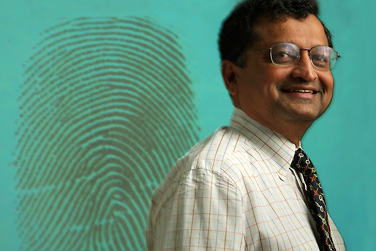Q&A
Sargur Srihari
SUNY Distinguished Professor in the Department of Computer Science and Engineering and director of the Center of Excellence in Document Analysis and Recognition (CEDAR), served on a National Academy of Sciences panel charged with exploring the current status and future of the forensic sciences. The panel recently released its findings in a report called “Strengthening Forensic Science in the United States: A Path Forward.”

How has serving on the NAS committee influenced your perception of how much science can be applied to forensics?
I am a believer in strong artificial intelligence. Given sufficient time and resources, specific intelligent tasks that humans perform can be automated. The NAS report puts the focus on the need to develop more objective methods. One of the areas that I hope we will be able to develop is something I call “computational forensics.” It is about developing algorithms and software to perform forensic analysis. And hopefully, financial support of research in the forensic sciences will improve.
How has your research evolved to rigorously apply science to forensics?
My research has been in the field of computer science known as pattern recognition, which is about getting computers to perform cognitive tasks normally performed by skilled humans, such as recognizing handwriting. That interest resulted in my work being funded by the U.S. Postal Service. Today, more than 95 percent of all handwritten addresses in the U.S. are processed by computer. But the techniques of pattern recognition are far more general, and forensics is a natural application. The Supreme Court ruling in Daubert v. Merrell Dow stated that pattern evidence had to have a proven scientific basis to be allowed in court. My colleagues and I at CEDAR found that with high-speed computers, for example, we were able to conduct large-scale tests to determine the degree of individuality and uniqueness in a given fingerprint.
How has the use of DNA evidence changed the field of forensics?
The accuracy of DNA analysis has raised expectations for other forensic modalities, but DNA is available only in about 10 percent of cases. As with DNA, it would be useful for other types of evidence to provide exact probabilities of having a random match. Such probability calculations are to a large extent lacking.
What are some of the biggest challenges in trying to bring science into the courtroom?
Judges are open to hearing scientific testimony. However, they have to make sure in a preliminary hearing that it will be presented in a form that is understandable to a lay jury.
Can you talk about the backlash from some defense attorneys using the term “junk science” to discredit scientific methods in the courtroom?
This report will galvanize defense attorneys’ position that the scientific basis for introducing evidence is lacking. But justice has to be carried out. With this report, judges and juries can become more aware that there is always an inherent error rate, and therefore multiple types of evidence should be considered in arriving at a final decision.

Reader Comments